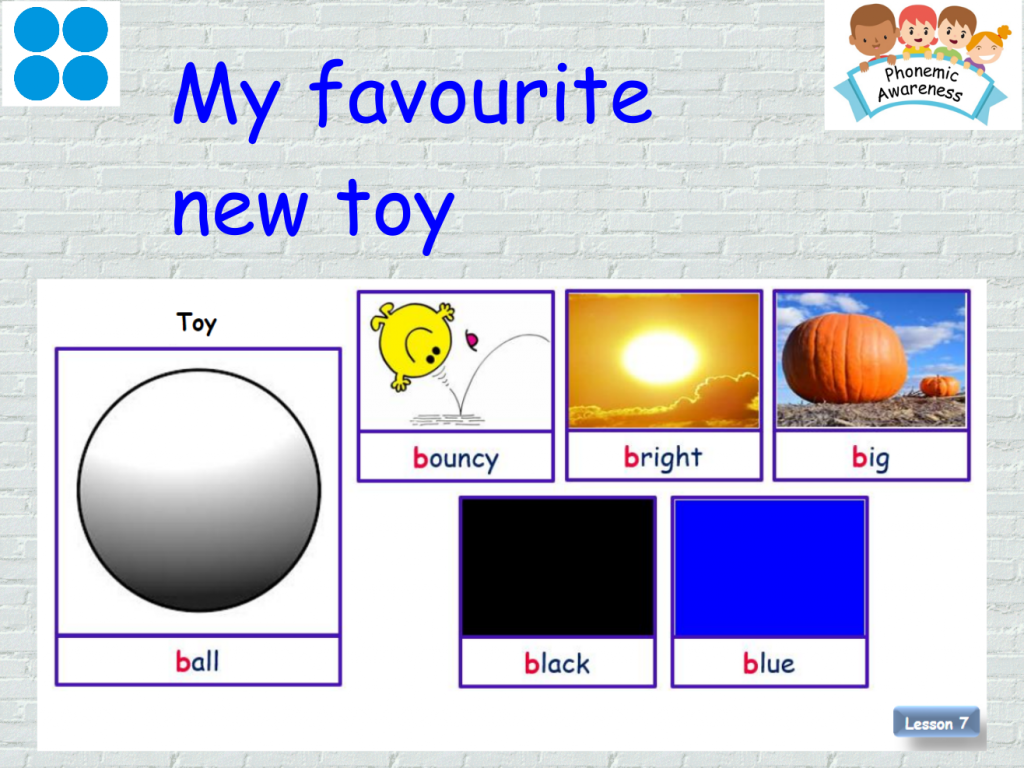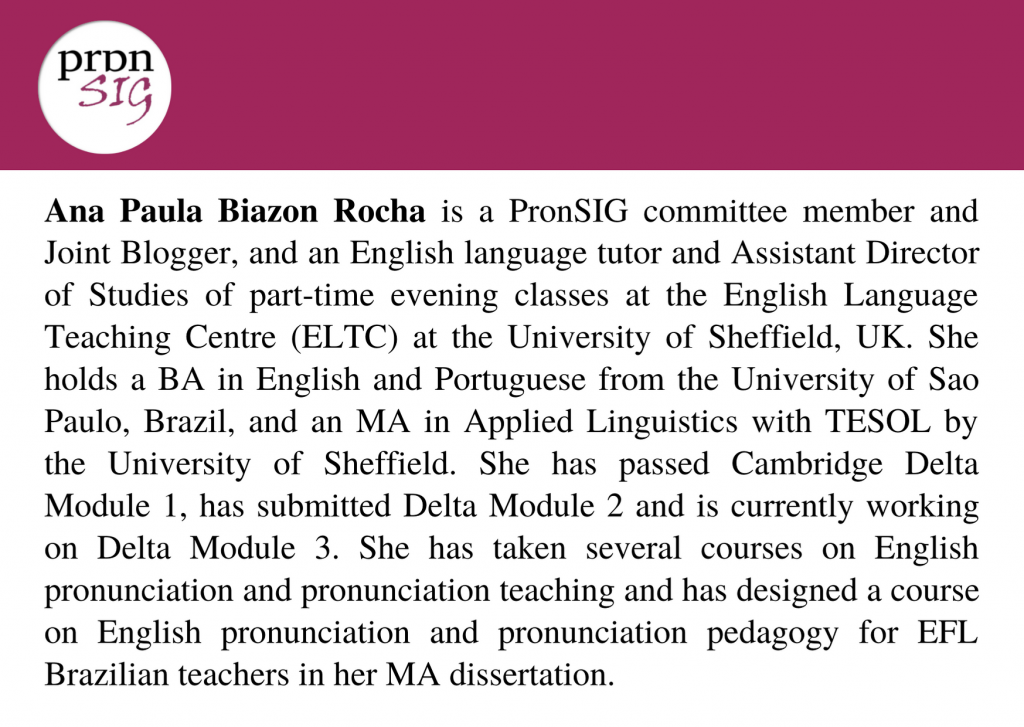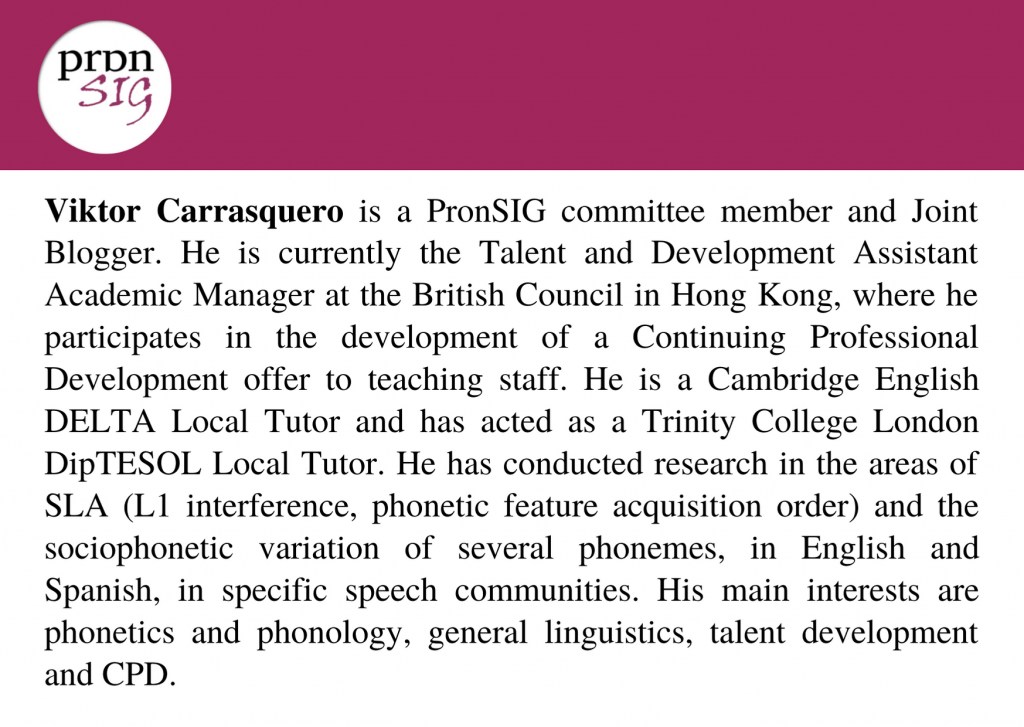Notes on Viktor Carrasquero’s webinar about Ideas for fostering phonological awareness in the Early Years class
by Ana Paula Biazon Rocha and Viktor Carrasquero
In last month’s PronSIG’s webinar, Viktor Carrasquero shared his experience of creating an online pronunciation course for 3 to 5-year-old students in Hong Kong. The course mainly focused on developing these very young learners’ phonological awareness. In this post, we will find out more about Viktor’s presentation, and have Viktor himself answer some questions.
Initially, we were all very curious about how to define pronunciation priorities in very young learners’ classes. Then, Viktor reminded us that they are already able to recognise sounds, so the work starts by exploring that. He also explained the main differences between the following aspects:
- Phonemic awareness: knowledge of sound units
- Phonics: reading and writing
- Phonetics: linguistic sound production and perception
When working with very young learners, we should focus on phonemic awareness, training them to identify, isolate and combine sounds. For example, by telling stories, Viktor raised students’ awareness of sounds they are familiar with, such as environmental sounds (e.g., shoes when someone is walking), instrumental sounds (e.g. maracas, castanets, xylophone, drums) and the sound of animals. Learners were then stimulated to recreate the stories through these sounds.
By having students imitate the quality of the sounds, Viktor introduced important phonological features such as rhythm, speed and volume, or quiet, loud, slow and fast:

Picture 1. Students did body percussion activities at different speeds and volumes.
Copyright Viktor Carrasquero.
Viktor also used alliterations and rhymes to help learners recognise and isolate word initial and final sounds:

Picture 2. Students did activities such as inventing a new favourite toy, with alliterative sounds.
Copyright Viktor Carrasquero.
This process of phonemic awareness involves a combination of TPR (Total Physical Response), playful activities, teacher’s creativity, visual and sound stimuli, and motivation, in order to provide learners with a didactic and extremely fun experience.
We were all fascinated by the endless possibilities of using sounds to develop phonological awareness. For teachers who usually work with young learners, there were loads of examples and ideas worth following and exploring. For teachers who are more used to teaching teenagers or adults, the session was equally inspiring and fun.
Now, let’s turn to Viktor and his answers to the following questions:
1. What were your initial impressions about working with these very young learners, when you started creating the course, and later, when you taught it?
Viktor: To be honest, I was a little apprehensive. I thought that some of the ideas I wanted the children to work on, such as sound, pitch, rhyme and alliteration, were going to be challenging to convey, for the learners to understand in practical terms. However, by ensuring that tasks and materials were appealing, age-appropriate and conducive to play, all the students were able to not only understand the notions, but to play with them, singing, dancing to the beat of their own drumming, creating animal stories, and talking about what other children do. Setting up a motivating, learner-relevant context is always important, the Early Years classroom is no exception.
2. Did you share ideas or tested activities with your peers? How did peer collaboration contribute to the creation and teaching of the course?
Viktor: I was fortunate to have a colleague, Monica Goh, an expert in Early Years ELT and phonics, tell me about our students’ fundamental needs. She was the one who initially approached me with the idea of creating a course to support learners before they started their phonics training. She also kept me in check, whenever I planned lessons that she deemed too demanding – or too simple! – for this age group. I was also lucky that another teacher got to teach the course. Her questions helped me further rationalise the idea behind some of the activities and the notions I wanted the learners to practise. Her experience was equally positive: her learners were very engaged and effectively managed to produce and reproduce the sound nuances and aspects of the course.
3. Which aspects of the course do you think could be changed or adapted for the future?
Viktor: I loved planning and delivering the first iteration of the course, but I know now that the final lessons need to have an even greater focus on linguistic sound blending and segmenting. While I introduced notions that support these two phonics sub-skills, I believe learners should be, at least, exposed to the practical principles of reading and writing. Much of my intention in creating this course was to pique learners’ interest, to get them thinking about sounds, to make them curious about volume, pitch, tempo. However, we should also get learners to pay some attention to the written system of language, if the course is to provide true foundations for both reading and writing. In a second iteration of this course, I may introduce some play with letters, so that learners get used to the idea of letters representing sound.
As you can see, Viktor’s webinar is unmissable! Click here to watch it.
You can also check Viktor’s previous monthly commentaries on PronSIG’s past webinars and other blog posts here.
Don’t forget to follow PronSIG on social media and leave your comments below.



